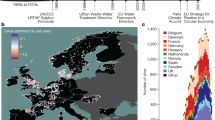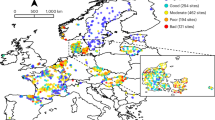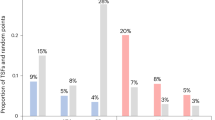Abstract
Coal mining is a major cause of land-use change in the US, and according to the Energy Information Administration it is expected to remain a key part of the national electricity portfolio until at least 2040. It is therefore crucial to understand the environmental impact of coal mining. Although a scientific consensus has emerged that coal mining negatively affects water quality, a quantitative synthesis of biodiversity impacts is currently lacking. Here, we show that mining under current federal statutes—the 1972 Clean Water Act and the 1977 Surface Mining Control and Reclamation Act—has negative implications for freshwater biota. Streams affected by coal mining averaged one-third (32%) lower taxonomic richness and one-half (53%) lower total abundance than unmined streams, with these impacts occurring across all taxa investigated thus far (invertebrates, fish, and salamanders). Even after post-mining reclamation, biodiversity impacts persisted. Our investigation demonstrates that current US regulations are insufficient to fully protect stream biodiversity.
This is a preview of subscription content, access via your institution
Access options
Access Nature and 54 other Nature Portfolio journals
Get Nature+, our best-value online-access subscription
$29.99 / 30 days
cancel any time
Subscribe to this journal
Receive 12 digital issues and online access to articles
$119.00 per year
only $9.92 per issue
Buy this article
- Purchase on Springer Link
- Instant access to full article PDF
Prices may be subject to local taxes which are calculated during checkout



Similar content being viewed by others
References
US Energy Information Administration Annual Energy Outlook 2017 (2017).
Copeland, C. The Office of Surface Mining’s Proposed Stream Protection Rule: an Overview (Congressional Research Service, 2015).
Bernhardt, E. S. & Palmer, M. A. The environmental costs of mountaintop mining valley fill operations for aquatic ecosystems of the Central Appalachians. Ann. NY Acad. Sci. 1223, 39–57 (2011).
Palmer, M. A. et al. Mountaintop mining consequences. Science 327, 148–149 (2010).
The Effects of Mountaintop Mines and Valley Fills on Aquatic Ecosystems of the Central Appalachian Coalfields EPA/600/R-09/138F (US Environmental Protection Agency, 2011).
Bryant, G. & Childers, H. A Survey of the Water Quality of Streams in the Primary Region of Mountaintop Mining/valley Fill Coal Mining. Mountaintop Mining/Valley Fills in Appalachia Draft Programmatic Environmental Impact Statement, Appendix D EPA 9-03-R-00013B (US Environmental Protection Agency, 2003).
Lemly, A. D. Selenium Assessment in Aquatic Ecosystems: A Guide for Hazard Evaluation and Water Quality Criteria (Springer, New York, 2002).
Hartman, K. J. et al. How much do valley fills influence headwater streams? Hydrobiologia 532, 91–102 (2005).
Kimmer, W. G. & Argent, D. G. Stream fish community responses to a gradient of specific conductance. Water Air Soil Pollut. 206, 49–56 (2010).
Griffith, M. B., Norton, S. B., Alexander, L. C., Pollard, A. L. & LeDuc, S. D. The effects of mountaintop mines and valley fills on the physicochemical quality of stream ecosystems in the Central Appalachians: a review. Sci. Total Environ. 417–418, 1–12 (2012).
Lindberg, T. T. et al. Cumulative impacts of mountaintop mining on an Appalachian watershed. Proc. Natl Acad. Sci. USA 108, 20929–20934 (2011).
Opinion and Order. People of the State of Illinois V. Freeman United Coal Mining Company, Llc, A Delaware Limited Liability Company, and Springfield Coal Company, Llc, A Delaware Limited Liability Company; Environmental Lawand Policy Center V Freeman United Coal Mining Company, Llc, A Delaware Limited Liability Company, and Springfield Coal Company, Llc, A Delaware Limited Liability Company (Consolidated: Pcb 10-61 and 11-2) (Illinois Pollution Control Board, 2012).
Pond, G. J. Biodiversity loss in Appalachian headwater streams (Kentucky, USA): Plecoptera and Trichoptera communities. Hydrobiologia 679, 97–117 (2012).
Pond, G. J. et al. Downstream effects of mountaintop coal mining: comparing biological conditions using family- and genus-level macroinvertebrate bioassessment tools. J. North Am. Benthol. Soc. 27, 717–737 (2008).
Howard, H. S. et al. Kentucky Mountaintop Mining Benthic Macroinvertebrate Survey: Central Appalachian Ecoregion, Kentucky. Mountaintop Mining/Valley Fills in Appalachia Draft Programmatic Environmental Impact Statement, Appendix D EPA 9-03-R-00013B (US Environmental Protection Agency, 2003).
Merricks, T. C. et al. Coal-mine hollow fill and settling pond influences on headwater streams in southern West Virginia, USA. Environ. Monit. Assess. 129, 359–378 (2007).
Armstead, M. Y., Yeager-Seagle, J. L. & Emerson, L. Benthic macroinvertebrate studies conducted in mountaintop mining/valley fill influenced streams in conjunction with the USEPA environmental impact study. Proc. Am. Soc. Min. Reclam. 2004, 87–93 (2004).
Pond, G. J. et al. Long-term impacts on macroinvertebrates downstream of reclaimed mountaintop mining valley fills in Central Appalachia. Environ. Manage. 54, 919–933 (2014).
Muncy, B. L., Price, S. J., Bonner, S. J. & Barton, C. D. Mountaintop removal mining reduces stream salamander occupancy and richness in southeastern Kentucky. Biol. Conserv. 180, 115–121 (2014).
Fritz, K. M. et al. Structural and functional characteristics of natural and constructed channels draining a reclaimed mountaintop removal and valley fill coal mine. J. North Am. Benthol. Soc. 29, 673–689 (2010).
Ferreri, C. P., Stauffer, J. R. & Stecko, T. D. Evaluating impacts of mountain top removal/valley fill coal mining on stream fish populations. Proc. Am. Soc. Min. Reclam. 2004, 576–592 (2004).
Stauffer, J. R. Jr & Ferreri, C. P. Characterization of Stream Fish Assemblages in Selected Regions of Mountain Top Removal/valley Fill Coal Mining. Mountaintop Mining/Valley Fills in Appalachia Draft Programmatic Environmental Impact Statement, Appendix D EPA 9-03-R-00013B (US Environmental Protection Agency, 2003).
Wood, P. B. & Williams, J. M. Impact of valley fills on streamside salamanders in Southern West Virginia. J. Herpetol. 47, 119–125 (2013).
Chao, A. & Jost, L. Coverage-based rarefaction and extrapolation: standardizing samples by completeness rather than size. Ecology 93, 2533–2547 (2012).
Sutton, A. J. in The Handbook of Research Synthesis and Meta-Analysis 2nd edn (eds Cooper H., Hedges, L. V. & Valentine, J. C.) 435–452 (Russel Sage Foundation, New York, 2009).
Annual Production Data from Annual Coal Report 2016 (US Energy Information Administration, 2017).
Digital distribution of native US fishes by watershed v. 3.0. NatureServe http://www.natureserve.org/conservation-tools/data-maps-tools/digital-distribution-native-us-fishes-watershed (2010).
Kier, G. et al. A global assessment of endemism and species richness across island and mainland regions. Proc. Natl Acad. Sci. USA 106, 9322–9327 (2009).
Crystallaria cincotta: IUCN Red List of Threatened Species https://doi.org/10.2305/IUCN.UK.2013-1.RLTS.T202435A15362696.en (2013).
Blanton, R. E. & Jenkins, R. E. Three new darter species of the Etheostoma pecnurum species complex (Percidae, subgenus Catonotus) from the Tennessee and Cumberland river drainages. Zootaxa 1963, 1–24 (2008).
Etheostoma spilotum: IUCN Red List of Threatened Species. https://doi.org/10.2305/IUCN.UK.2014-3.RLTS.T18243637A19033189.en (2014).
Chrosomus cumberlandensis: IUCN Red List of Threatened Species. https://doi.org/10.2305/IUCN.UK.2014-3.RLTS.T17064A15364473.en (2014).
Merriam, E. R., Petty, J. T., Strager, M. P., Maxwell, A. E. & Ziemkiewicz, P. F. Complex contaminant mixtures in multistressor Appalachian riverscapes. Environ. Toxicol. Chem. 34, 2603–2610 (2015).
van der Welle, M. E. W., Roelofs, J. G. M. & Lamers, L. P. M. Multi-level effects of sulphur-iron interactions in freshwater wetlands in the Netherlands. Sci. Tot. Environ. 40, 426–429 (2008).
Armstead, M. Y., Bitzer-Creathers, L. & Wilson, M. The effects of elevated specific conductivity on the chronic toxicity of mining influenced streams using Ceriodaphnia dubia. PLoS ONE 11, e0165683 (2016).
Rose, A. W. & Cravotta, C. A. III Geochemistry of Coal Mine Drainage. Coal Mine Drainage Prediction and Pollution Prevention in Pennsylvania (Pennsylvania Department of Environmental Protection, Harrisburg, 1998).
Petty, J. T. et al. Landscape indicators and thresholds of stream ecological impairment in an intensively mined Appalachian watershed. J. N. Am. Benthol. Soc. 29, 1292–1309 (2010).
Schorr, M. S. & Backer, J. C. Localized effects of coal mine drainage on fish assemblages in a Cumberland Plateau stream in Tennessee. J. Freshwat. Ecol. 21, 17–24 (2006).
Smucker, N. J. & Vis, M. L. Use of diatoms to assess agricultural and coal mining impacts on streams and a multiassemblage case study. J. N. Am. Benthol. Soc. 28, 659–675 (2009).
Schmidt, T. S., Soucek, D. J. & Cherry, D. S. Integrative assessment of benthic macroinvertebrate community impairment from metal-contaminated waters in tributaries of the Upper Powell River, Virginia, USA. Environ. Toxicol. Chem. 21, 2233–2241 (2002).
MacCausland, A. & McTammany, M. E. The impact of episodic coal mine drainage pollution on benthic macroinvertebrates in streams in the Anthracite region of Pennsylvania. Environ. Pollut. 149, 216–227 (2007).
Bott, T. L. et al. Abandoned coal mine drainage and its remediation: impacts on stream ecosystem structure and function. Ecol. Appl. 22, 2144–2163 (2012).
Palmer, M. A. & Hondula, K. L. Restoration as mitigation: analysis of stream mitigation for coal mining impacts in southern Appalachia. Environ. Sci. Tech. 48, 10552–10560 (2014).
Osenberg, C. W., Shima, J. S., Miller, S. L. & Stier, A. C. in Marine Protected Areas: A Multidisciplinary Approach (ed. Claudet, J.) 143–167 (Cambridge Univ. Press, 2011).
Stream Protection Rule (Dec 20 2016) 81 FR 93066 (US Federal Govt, 2016).
West Virginia to improve oversight of coal-mining pollution. Federal review of West Virginia coal mining reveals chronic failures Center for Biological Diversity https://www.biologicaldiversity.org/news/press_releases/2017/coal-02-07-2017.php (2017).
Bernhardt, E. S. et al. How many mountains can we mine? Assessing the regional degradation of central Appalachian rivers by surface coal mining. Environ. Sci. Tech. 46, 8115–8122 (2012).
Hendryx, M. & Ahern, M. M. Mortality in Appalachian coal mining regions: the value of statistical life lost. Public Health Rep. 124, 541–550 (2010).
2012 National Survey of Hunters and Anglers (Chesapeake Beach Consulting, 2012).
Hedges, L. V., Gurevitch, J. & Curtis, P. S. The meta-analysis of response ratios in experimental ecology. Ecology 80, 115–1156 (1999).
Hsieh, T. C., Ma, K. H. & Chao, A. An R package for rarefaction and extrapolation of species diversity (Hill numbers). Methods Ecol. Evol. 7, 1451–1456 (2016).
R Core Team R: A Language and Environment for Statistic Computing (R Foundation for Statistical Computing, 2017).
Viechtbauer, W. Conducting meta-analyses in R with the metafor package. J Stat. Softw. 36, 1–48 (2010).
Knapp, G. & Hartung, J. Improved tests for a random effects meta-regression with a single covariate. Stat. Med. 22, 2693–2710 (2003).
Jacobsen, D. Low oxygen pressure as a driving factor for the altitudinal decline in taxon richness of stream macroinvertebrates. Oecologia 154, 795–807 (2008).
US Coal Fields https://hifld-geoplatform.opendata.arcgis.com/datasets?q=Coal%20Fields%20of%20the%20United%20States (US Geological Survey, 2001).
Regulatory Impact Analysis of the Stream Protection Rule (Office of Surface Mining Reclamation and Enforcement, Industrial Economics, 2016).
ArcGIS Desktop 10.5 (ESRI, 2016).
Nagel, D. et al. National Stream Internet Hydrography Network for Spatial-Stream-Network (SSN) Analysis: Rocky Mountain Research Station https://www.fs.fed.us/rm/boise/AWAE/projects/NationalStreamInternet/NSI_network.html (US Forest Service Data Archive, 2017).
Watershed Boundary Dataset and Lines for HUC2–12 (US Geological Survey, 2014).
Acknowledgements
Our study would not be possible without the original studies that went into our meta-analysis. We thank all authors and researchers who led and participated in the original research. We are particularly grateful to G. Pond, J. Simmons, M. Vis, B. Verb, N. Smucker, T. Schmidt, D. Soucek, M. Yeager-Armstead and K. Fritz for generously sharing information and/or data. We thank M. Palmer, E. Bernhardt and D. Rifkin for insightful discussions and comments on a previous version of this paper. Finally, we thank C. Osenberg for thoughtful comments and suggestions that improved our paper substantially.
Author information
Authors and Affiliations
Contributions
X.G. conceived the study, performed the analyses, and led the writing of the paper. J.D.O. and D.S. provided input into data analyses and contributed to writing the paper.
Corresponding author
Ethics declarations
Competing interests
The authors declare no competing interests.
Additional information
Publisher’s note: Springer Nature remains neutral with regard to jurisdictional claims in published maps and institutional affiliations.
Supplementary information
Supplementary Information
Supplementary Figs. 1–6, Supplementary Tables 1–6
Supplementary Data
Supplementary Data 1 and 2, Supplementary Code 1
Rights and permissions
About this article
Cite this article
Giam, X., Olden, J.D. & Simberloff, D. Impact of coal mining on stream biodiversity in the US and its regulatory implications. Nat Sustain 1, 176–183 (2018). https://doi.org/10.1038/s41893-018-0048-6
Received:
Accepted:
Published:
Issue Date:
DOI: https://doi.org/10.1038/s41893-018-0048-6
This article is cited by
-
Quantifying the spatiotemporal patterns and environmental impacts of surface coal mining in the Xilingol Steppe, Inner Mongolia
Regional Environmental Change (2024)
-
Constructing soils for climate-smart mining
Communications Earth & Environment (2023)
-
A Landscape-Scale Comparison of Wetlands Associated with Surface Coal Extraction and Naturally-Occurring Wetlands in the Central Appalachian Mountains, USA
Wetlands (2023)
-
Effects of a coal phase-out in Europe on reaching the UN Sustainable Development Goals
Environment, Development and Sustainability (2023)
-
Assessment of the capability of SWAT model to predict surface runoff in open cast coal mining areas
Environmental Science and Pollution Research (2023)



